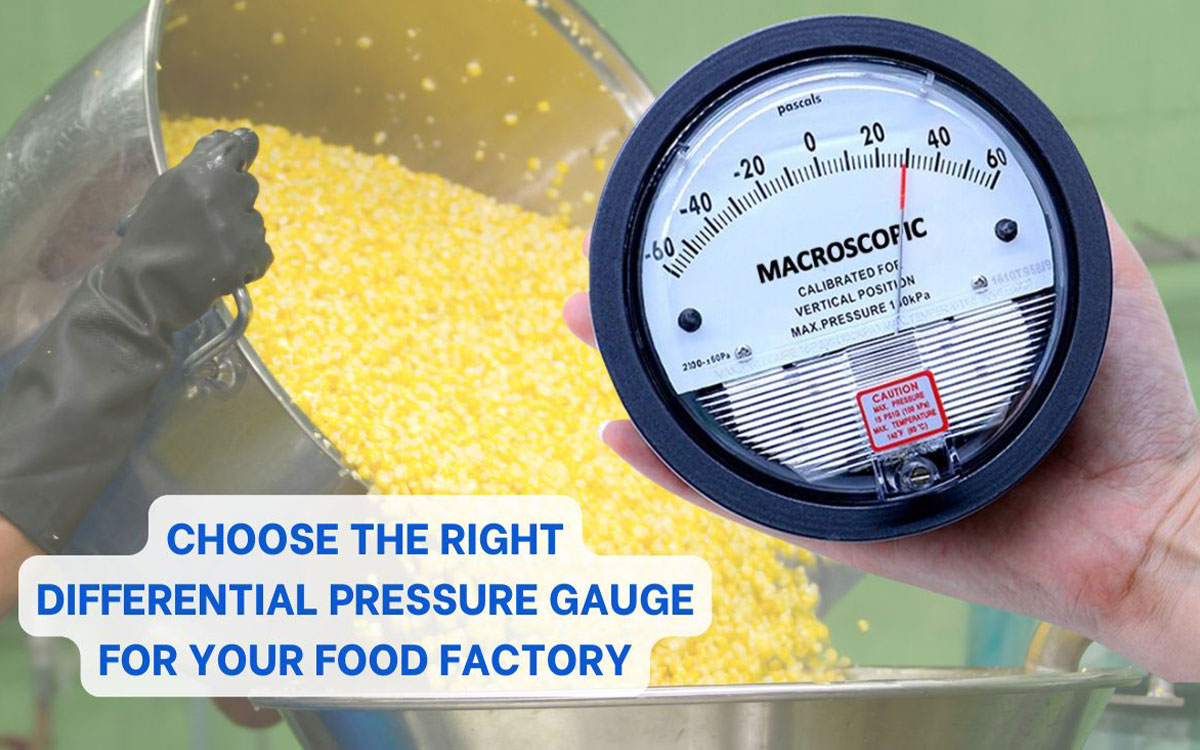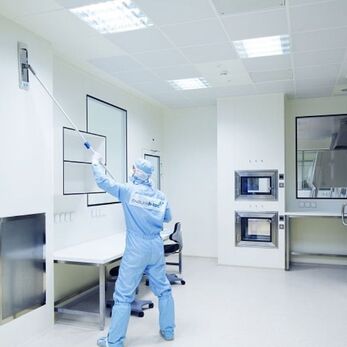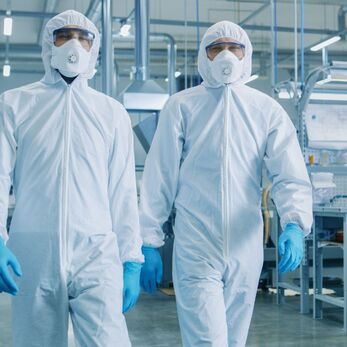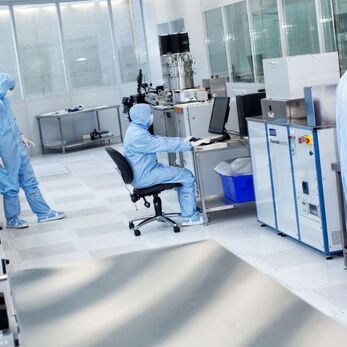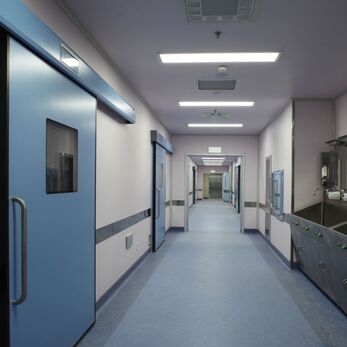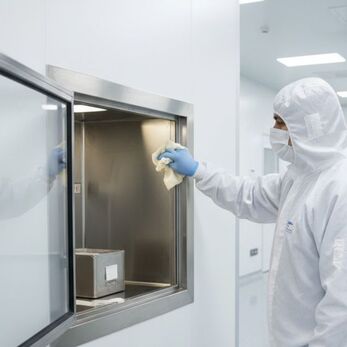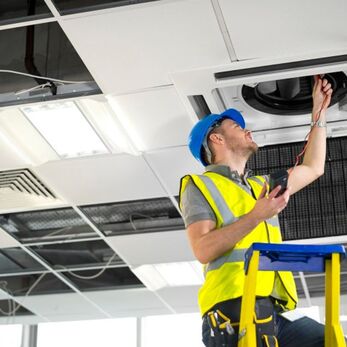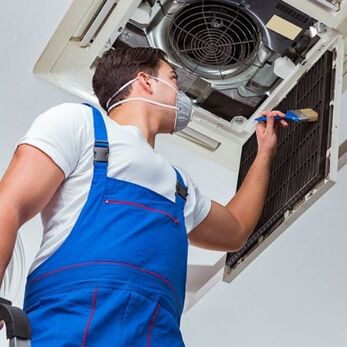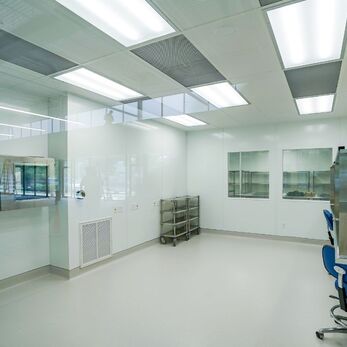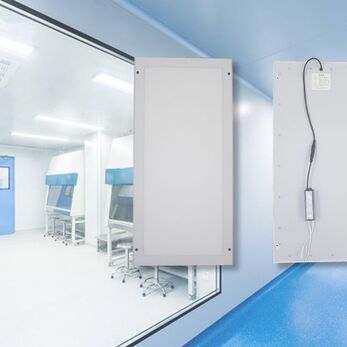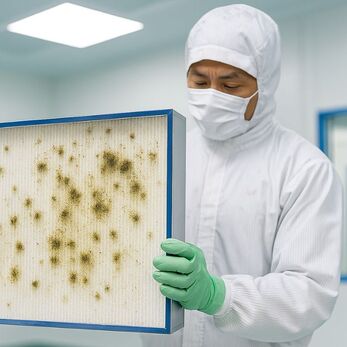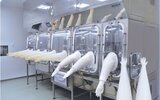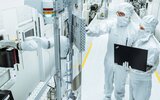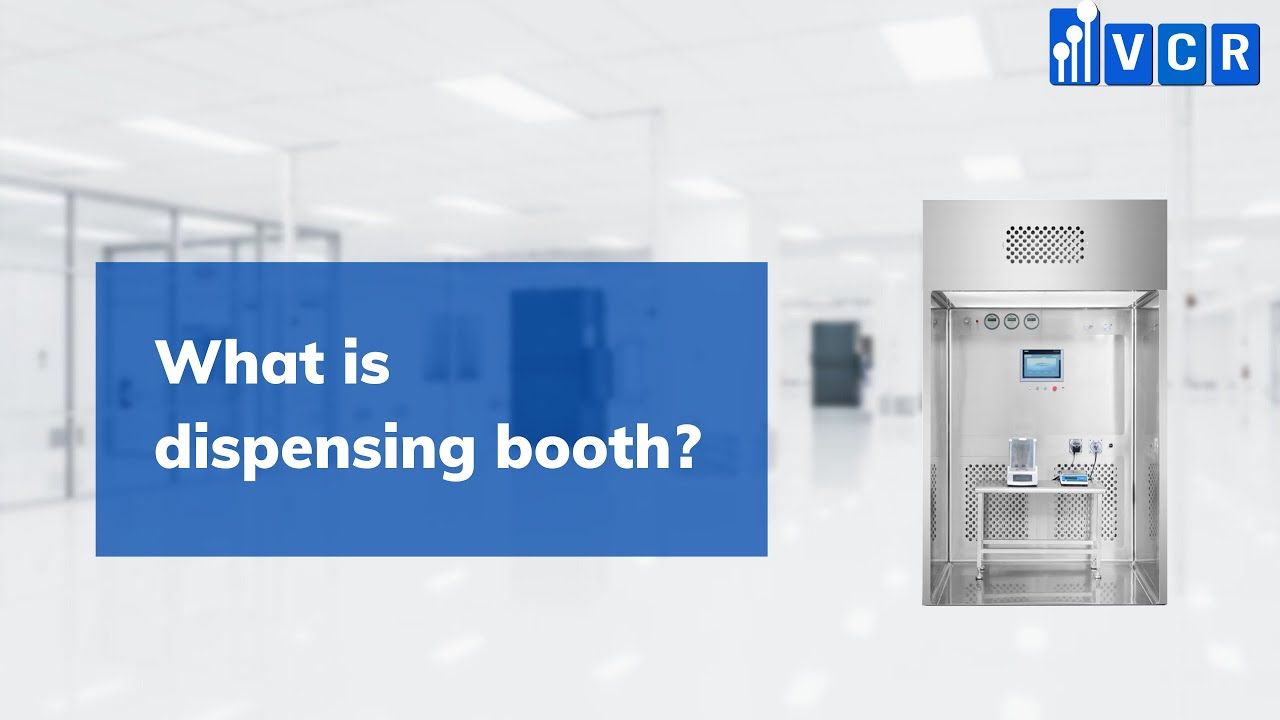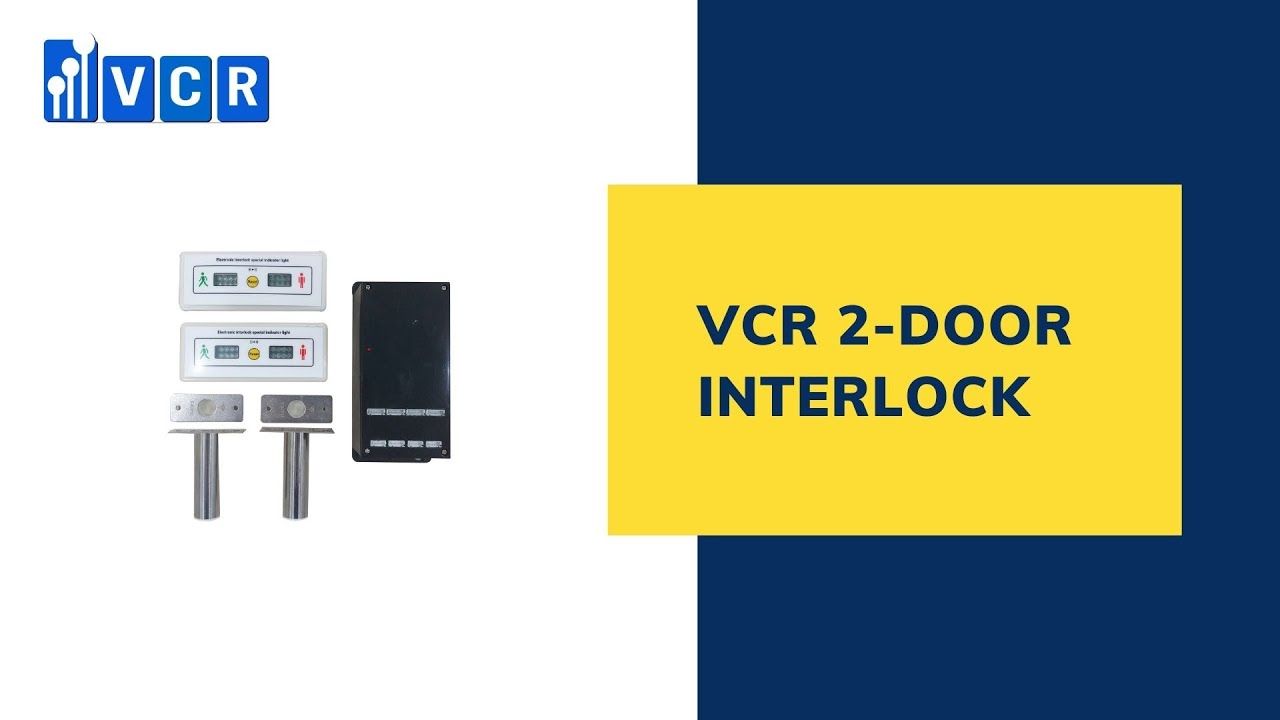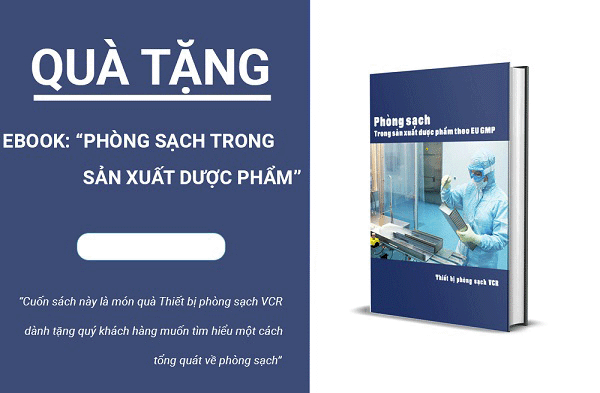How to Choose the Right Differential Pressure Gauge for Your Food Factory
One of the key elements in controlling this environment is differential pressure monitoring, which helps maintain air quality and prevents the spread of airborne contaminants between different zones within a food factory
1. Introduction
Importance of Differential Pressure Monitoring in Food Factories
In the food industry, maintaining a controlled production environment is crucial to ensuring food safety, preventing contamination, and complying with strict hygiene regulations. One of the key elements in controlling this environment is differential pressure monitoring, which helps maintain air quality and prevents the spread of airborne contaminants between different zones within a food factory.
- Ensuring food safety and hygiene compliance
Food production facilities must adhere to stringent hygiene standards to prevent microbial contamination. Proper differential pressure monitoring ensures positive pressure in clean zones and negative pressure in contaminated areas, thereby minimizing the risk of cross-contamination.
- Preventing cross-contamination between different zones
Different sections in food factories, such as raw material storage, processing areas, and packaging zones, require precise pressure control to prevent airborne contaminants from moving from one area to another. For instance, packaging areas should maintain higher pressure than storage areas to prevent dust and contaminants from entering the packaging process.
Regulatory bodies, including HACCP (Hazard Analysis and Critical Control Points), GMP (Good Manufacturing Practices), and ISO 22000, emphasize the importance of air quality control in food production facilities. Maintaining proper differential pressure ensures that companies comply with these regulations, preventing product recalls and legal violations.
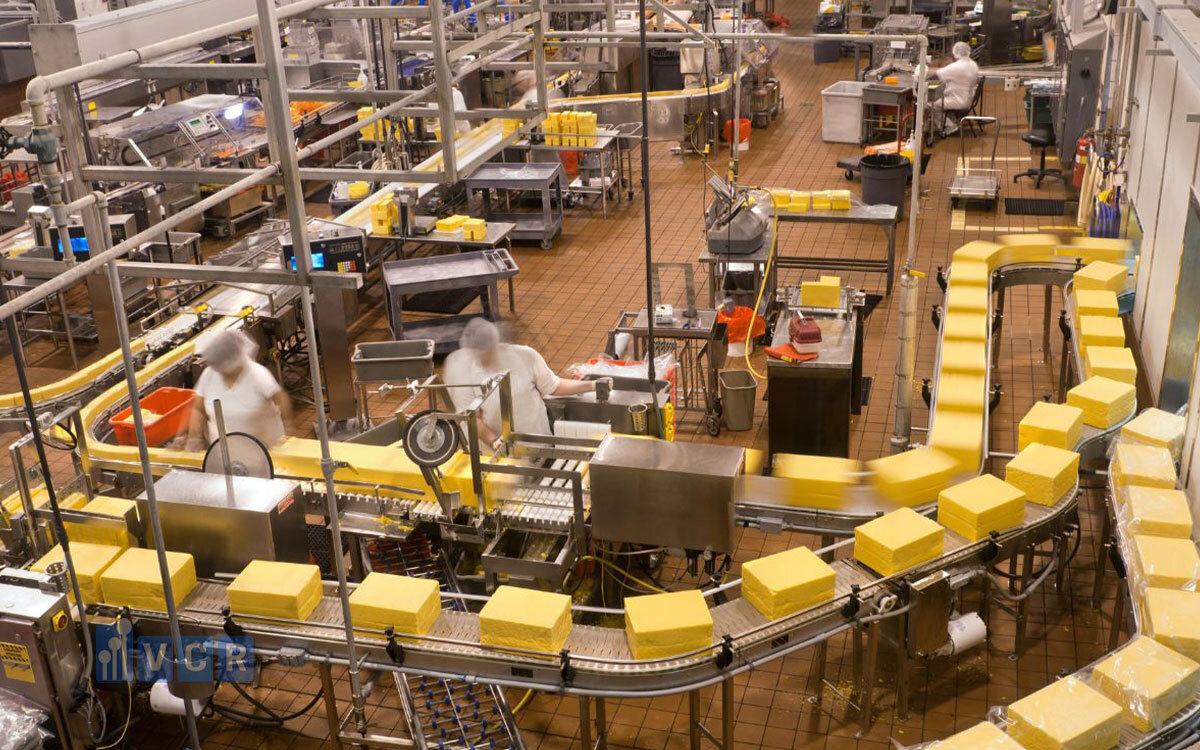
Why Choosing the Right Differential Pressure Gauge Matters
Selecting the correct differential pressure gauge is critical to ensuring accurate monitoring and maintaining a well-controlled food production environment. An incorrect gauge selection can lead to inaccurate pressure readings, affecting air circulation, compromising food safety, and increasing operational costs due to inefficiencies.
Read more: 4 Applications Of Differential Pressure Gauge
Different areas in food production require precise pressure control
Not all sections of a food manufacturing facility require the same level of pressure monitoring.
- Processing and packaging areas require high-precision digital differential pressure gauges.
- Storage rooms and warehouses can use mechanical differential pressure gauges for cost-effective monitoring.
- HVAC and cleanroom systems often integrate advanced differential pressure sensors for automated pressure regulation.
Selecting the wrong gauge can lead to inaccurate readings and system inefficiencies
- Overestimating the required accuracy may result in unnecessary expenses.
- Using an outdated or inaccurate gauge can lead to regulatory violations and compromised product quality.
- Lack of remote monitoring capabilities in certain gauges may require more manual labor for maintenance and adjustments.
Overview of the Article
This article will provide a comprehensive guide on how to select the right differential pressure gauge for food factories. The following sections will cover:
- Types of Differential Pressure Gauges
A comparison of mechanical, digital, and sensor-based pressure gauges.
- Key Factors to Consider When Choosing a Gauge
Accuracy, sensitivity, durability, integration with automation systems, and maintenance requirements.
- Best Practices for Installation and Maintenance
Guidelines on proper installation, calibration, troubleshooting common issues, and ensuring long-term operational efficiency.
By the end of this guide, food industry professionals will be equipped with practical knowledge to make informed decisions and ensure that their differential pressure monitoring system aligns with food safety standards.
2. Understanding Differential Pressure Gauges
2.1. What is a Differential Pressure Gauge?
A differential pressure gauge is a device designed to measure the difference in pressure between two points within a system. Unlike standard pressure gauges that measure absolute or gauge pressure, a differential pressure gauge helps monitor pressure variations between separate environments, making it essential for controlled food manufacturing processes.
How It Works?
A differential pressure gauge consists of two input ports connected to different areas within a system. The gauge measures the pressure difference and provides a visual or digital reading, allowing operators to detect pressure imbalances that could affect food safety and production efficiency.
Measuring Pressure Differences Between Two Points
- In food processing plants, differential pressure gauges are used to ensure proper airflow direction, preventing contaminants from moving into sterile zones.
- A positive differential pressure in cleanrooms and food packaging areas ensures that unfiltered air does not enter.
- A negative differential pressure in waste disposal or high-contamination zones helps contain harmful particles, ensuring they do not spread to other areas.
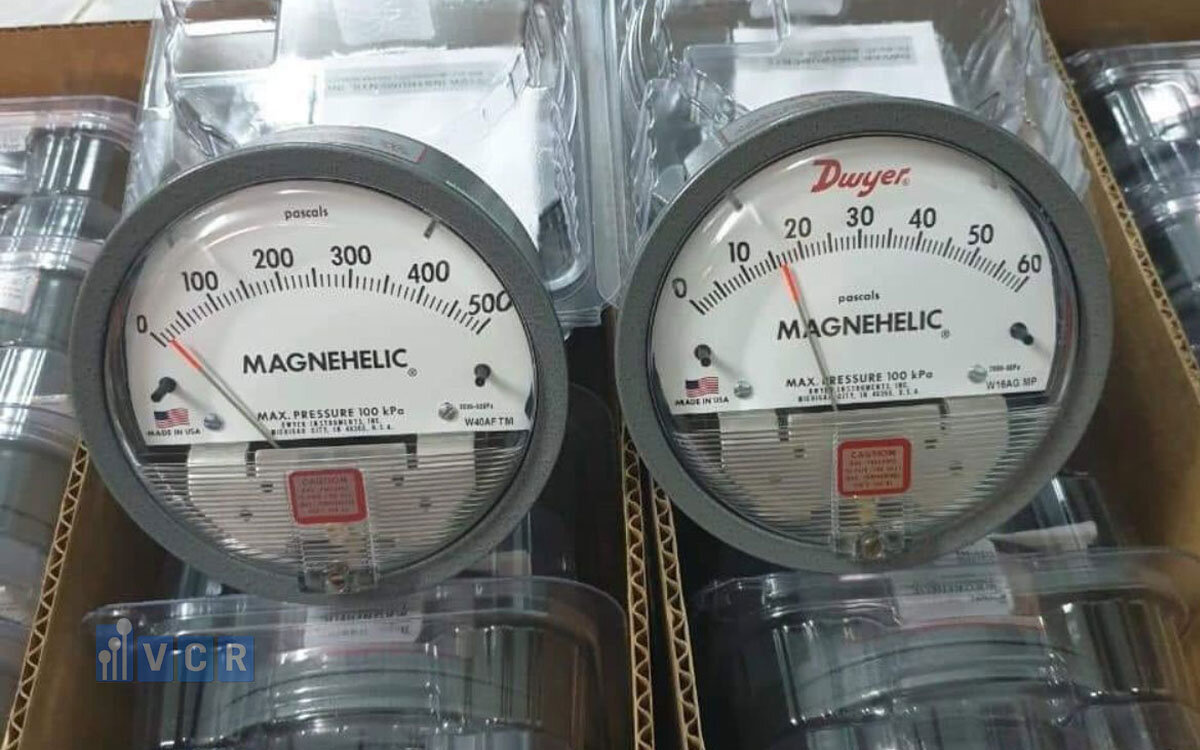
Common Applications in Food Manufacturing
- Cleanrooms – Preventing airborne contaminants in food production.
- Cold storage & warehouses – Ensuring air circulation and temperature stability.
HVAC & air filtration systems – Monitoring air filters to prevent blockages. - Food processing lines – Maintaining correct pressure to avoid contamination and meet HACCP, GMP, and ISO 22000 standards.
See our Differential Pressure Gauges here.
2.2. Types of Differential Pressure Gauges
Mechanical (Analog) Differential Pressure Gauges
Mechanical differential pressure gauges are non-electric devices that rely on mechanical movement to display pressure readings. They are widely used in food manufacturing due to their simplicity, durability, and cost-effectiveness.
- How They Work?
Operate using diaphragms, bellows, or pistons that respond to pressure differences.
Movement of these components translates into a needle movement on an analog dial.
- Key Features
No electricity required, making them suitable for locations where power availability is limited.
Highly durable, resistant to harsh environments, and capable of functioning in high humidity or extreme temperatures.
Easy to install and maintain, with minimal operational costs.
- Best Suited For
Storage rooms where maintaining airflow is crucial.
Basic airflow monitoring in non-critical zones such as ingredient storage and secondary packaging areas.
Digital Differential Pressure Gauges
Digital differential pressure gauges offer greater accuracy and advanced features compared to mechanical gauges. They display pressure readings digitally, allowing for better monitoring and real-time alerts.
- How They Work?
Equipped with electronic sensors that detect pressure differences.
Provide real-time pressure readings on an LCD or LED display.
Some models feature data logging and remote connectivity, enabling integration with modern factory automation systems.
- Key Features
Higher accuracy than mechanical gauges, reducing measurement errors.
Alarm functions for overpressure or pressure drop conditions, enhancing food safety measures.
Remote monitoring capabilities allow operators to track pressure changes via Wi-Fi or industrial control systems.
- Best Suited For
Cleanrooms & production zones requiring precise pressure control.
Automated food processing systems that integrate with SCADA (Supervisory
Control and Data Acquisition) systems.
Facilities needing compliance monitoring, where continuous data recording is required for audits.
Differential Pressure Sensors (Transducers & Transmitters)
For factories aiming for full automation and precision control, differential pressure sensors (also known as transducers or transmitters) are the best choice. These sensors convert pressure readings into electrical signals, allowing for seamless integration with HVAC systems, Building Management Systems (BMS), and IoT-based monitoring platforms.
- How They Work?
Sensors detect even the smallest pressure variations and convert them into digital signals.
Integrated into automated food processing and storage systems, ensuring continuous monitoring and adjustments.
Some advanced models include self-calibration and predictive maintenance alerts.
- Key Features
Extremely high accuracy (down to ±0.1% of full scale).
Seamless integration with factory automation for real-time adjustments.
Wireless or wired connectivity, allowing remote control via industrial software.
- Best Suited For
High-precision food processing environments such as beverage bottling, dairy processing, and pharmaceutical food production.
Integration with HVAC systems, ensuring optimal airflow and pressure control.
Food factories that require advanced quality assurance, enabling data logging for compliance with ISO 22000 and FDA regulations.
Key Takeaways
|
Type
|
Best Use Cases | Key Advantages | Limitations |
| Mechanical Differential Pressure Gauges | Storage rooms, basic airflow control | Cost-effective, durable, easy to install | Lower accuracy, no remote monitoring |
| Digital Differential Pressure Gauges | Cleanrooms, automated production zones | High accuracy, real-time monitoring, alarm functions | Requires power source, higher initial cost |
| Differential Pressure Sensors | High-precision food processing, HVAC systems | Most accurate, integrates with automation, predictive maintenance | Expensive, requires calibration and technical expertise |
3. Factors to Consider When Choosing a Differential Pressure Gauge
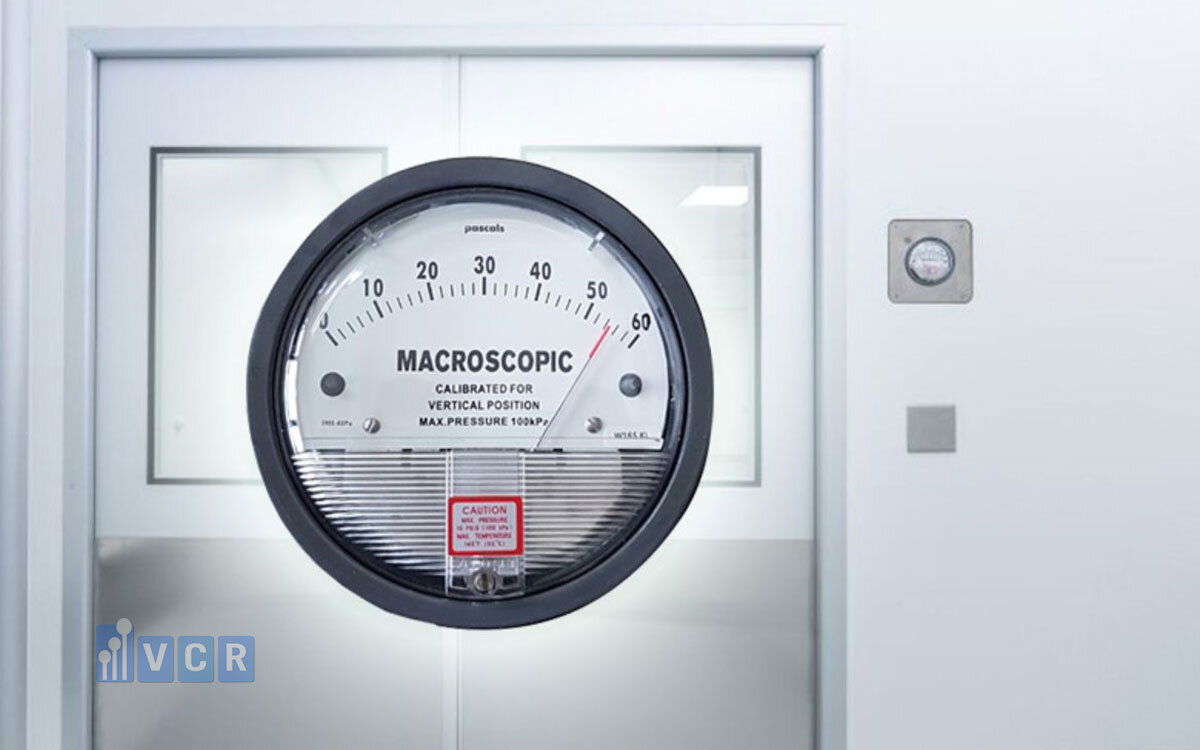
3.1. Accuracy & Sensitivity
3.2. Pressure Range & Scale Selection
Choosing the correct pressure range is essential for obtaining accurate readings. A pressure range that is too high (e.g., 500 Pa) may overlook small pressure changes, while a range that is too low (e.g., 2 Pa) may cause overloading and errors.
Common differential pressure values in food factories vary by zone. Cleanrooms and sterile food processing areas typically require 10–25 Pa, cold storage and warehouses operate at 5–10 Pa, packaging and filling areas need 15–30 Pa, and exhaust and waste handling rooms maintain a negative 10–20 Pa pressure difference.
Proper calibration is necessary to maintain gauge accuracy. Mechanical gauges should be recalibrated every 6–12 months, while digital gauges and sensors with auto-calibration features require an annual check-up to ensure long-term reliability.
A gauge with a 5–50 Pa pressure range is ideal for general food production, as it covers most pressure requirements without compromising accuracy.
3.3. Durability & Environmental Compatibility
The material and design of a differential pressure gauge play a key role in resisting humidity, dust, and temperature fluctuations commonly found in food factories. Stainless steel housings are preferred for their resistance to corrosion, chemicals, and high humidity, while plastic casings are more affordable but less durable.
Food production areas often experience high moisture levels, making it essential to choose a gauge with IP65 or higher protection for resistance to water, dust, and frequent cleaning agents.
Certifications such as NSF (National Sanitation Foundation), FDA compliance, and ISO 22000 are necessary to ensure that the gauge meets food safety standards.
For long-term durability, stainless steel digital gauges or sensors with an IP65+ rating are recommended for food factories.
3.4. Ease of Installation & Maintenance
Installation complexity varies depending on the type of gauge. Mechanical gauges are easy to install and do not require electrical connections, while digital gauges and sensors need integration with power sources and automation systems.
Calibration frequency also differs across gauge types. Mechanical gauges require manual calibration every 6–12 months, digital gauges may have auto-calibration but should still be checked annually, while sensors (transmitters) often self-calibrate but require periodic validation to ensure accuracy.
Long-term maintenance costs also play a role in selection. Mechanical gauges have the lowest maintenance cost but may require frequent recalibration. Digital gauges require moderate maintenance, while sensors have higher initial costs but lower long-term expenses due to automation benefits.
Digital gauges strike a balance between ease of installation, accuracy, and maintenance efficiency, making them a solid choice for most food production facilities.
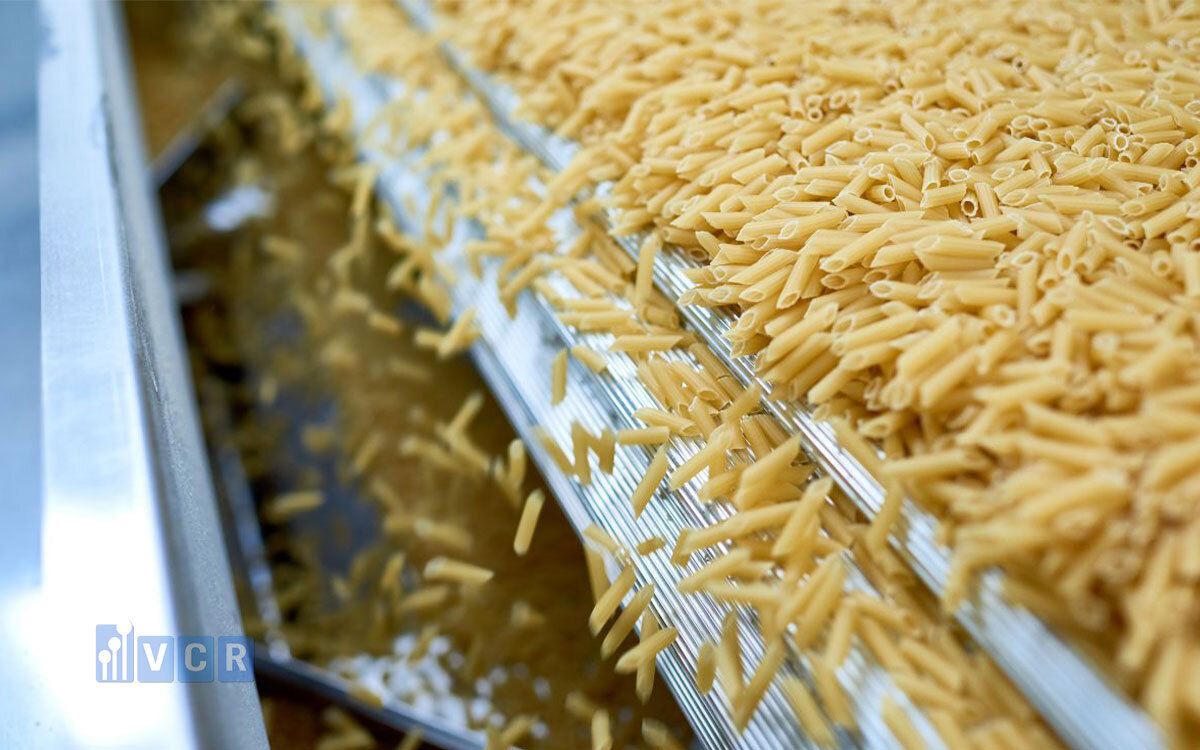
3.5. Integration with Automation & Monitoring Systems
If the food factory uses an HVAC or BMS (Building Management System), integrating digital gauges or sensors allows for real-time monitoring and automated pressure adjustments.
Remote monitoring capabilities reduce manual labor by automatically logging pressure data and sending alerts when pressure falls outside safe limits. This feature helps minimize human error and ensures quick corrective actions.
Sensors also play a vital role in automated pressure control, maintaining consistent airflow management in production areas and reducing contamination risks.
For advanced food processing environments, investing in sensors with remote monitoring capabilities ensures optimal efficiency, reduces downtime, and improves regulatory compliance.
Key Takeaways
The ideal differential pressure gauge depends on factors such as accuracy, cost, durability, and automation compatibility. Food manufacturers should evaluate their specific needs before selecting the best gauge type.
For cost-effective basic monitoring, mechanical gauges are a good option. For higher accuracy and partial automation, digital gauges are the better choice. For large-scale food factories requiring fully automated pressure control, differential pressure sensors offer the best long-term investment.
The next section will cover recommended differential pressure gauges for food factories, helping businesses make informed investment decisions.
4. Recommended Differential Pressure Gauges for Food Factories
Choosing the right differential pressure gauge for a food factory depends on factors like accuracy, durability, automation, and budget. Below is a guide to the best options available, categorized based on specific factory needs.
Top Mechanical Differential Pressure Gauge Brands for Food Storage Areas
Mechanical differential pressure gauges are ideal for food storage, warehouses, and non-critical areas where basic airflow monitoring is required. These gauges are cost-effective, durable, and require minimal maintenance.
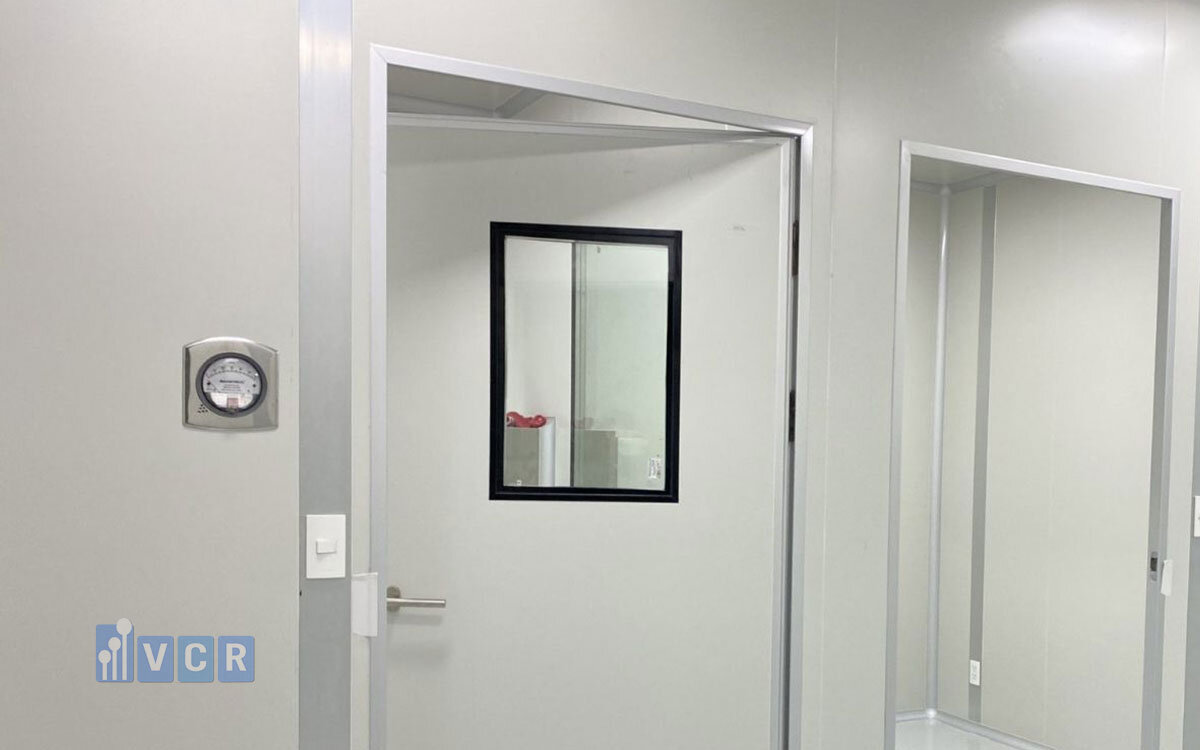
✅ Recommended Brands & Models:
Dwyer Magnehelic® Series 2000
- Accuracy: ±2% full-scale
- Best for: Food storage, packaging rooms, and air filter monitoring
- Key Features: No electricity required, easy installation, resistant to harsh environments
WIKA 716.05 Differential Pressure Gauge
- Accuracy: ±1.6% full-scale
- Best for: HVAC systems, warehouses, and general pressure monitoring
- Key Features: Robust stainless steel casing, good resistance to temperature fluctuations
Ashcroft 1130 Series
- Accuracy: ±2% full-scale
- Best for: Monitoring air filters and ventilation systems in food storage areas
- Key Features: Compact design, easy-to-read dial, low maintenance
Cost Comparison:
Mechanical differential pressure gauges are affordable, ranging from $50 to $250 per unit, making them a great choice for areas where real-time electronic monitoring is not necessary.
Best Digital Differential Pressure Gauges for Cleanrooms and Processing Zones
Digital differential pressure gauges are essential for cleanrooms, food processing areas, and highly regulated environments where precise monitoring and data logging are required. These gauges offer higher accuracy, digital displays, and remote connectivity options.
✅ Recommended Brands & Models:
Setra 267 Series
- Accuracy: ±0.5% full-scale
- Best for: Cleanrooms, food processing lines, and packaging zones
- Key Features: Digital display, data logging, remote monitoring capabilities
Testo 510 Digital Differential Pressure Gauge
- Accuracy: ±0.3% full-scale
- Best for: Food factories requiring HACCP and ISO compliance
- Key Features: Lightweight, portable, highly accurate, Bluetooth connectivity
Dwyer 477B-1 Digital Manometer
- Accuracy: ±0.5% full-scale
- Best for: HVAC pressure monitoring in food plants
- Key Features: Handheld, battery-powered, multiple pressure unit options
Cost Comparison:
Digital differential pressure gauges typically cost between $300 and $1,000, depending on features such as alarm systems, data logging, and wireless connectivity.
Advanced Pressure Sensors for High-Precision Manufacturing Lines
For high-precision food manufacturing lines, beverage bottling plants, and automated food processing systems, pressure sensors (also known as transducers or transmitters) are the most advanced option. These sensors offer real-time monitoring, automation, and system integration with HVAC and BMS (Building Management Systems).
✅ Recommended Brands & Models:
Setra Model 265 Low Differential Pressure Transducer
- Accuracy: ±0.25% full-scale
- Best for: Automated food production and pharmaceutical-grade food processing
- Key Features: Integrated with BMS, remote monitoring, ultra-low-pressure detection
Honeywell 24PC Series Pressure Sensor
- Accuracy: ±0.1% full-scale
- Best for: Precision food processing requiring strict air pressure control
- Key Features: High sensitivity, reliable output, easy integration with factory automation
Siemens QBM2030 Differential Pressure Sensor
- Accuracy: ±0.2% full-scale
- Best for: HVAC integration in large-scale food production plants
- Key Features: Long-term stability, compact design, programmable settings
Cost Comparison:
Pressure sensors are the most expensive but advanced solution, with prices ranging from $500 to $3,000 per unit, depending on automation and remote monitoring features.
Comparison of Cost vs. Features for Each Type
| Type | Best For | Accuracy | Price Range | Key Features |
| Mechanical Differential Pressure Gauges | Food storage, warehouses | ±1.6% to ±2% | $50 - $250 | Cost-effective, no power required, durable |
| Digital Differential Pressure Gauges | Cleanrooms, processing zones | ±0.3% to ±0.5% | $300 - $1,000 | Digital display, remote monitoring, alarm system |
| Pressure Sensors (Transducers & Transmitters) | High-precision automation, HVAC systems | ±0.1% to ±0.25% | $500 - $3,000 | Real-time monitoring, automation, system integration |
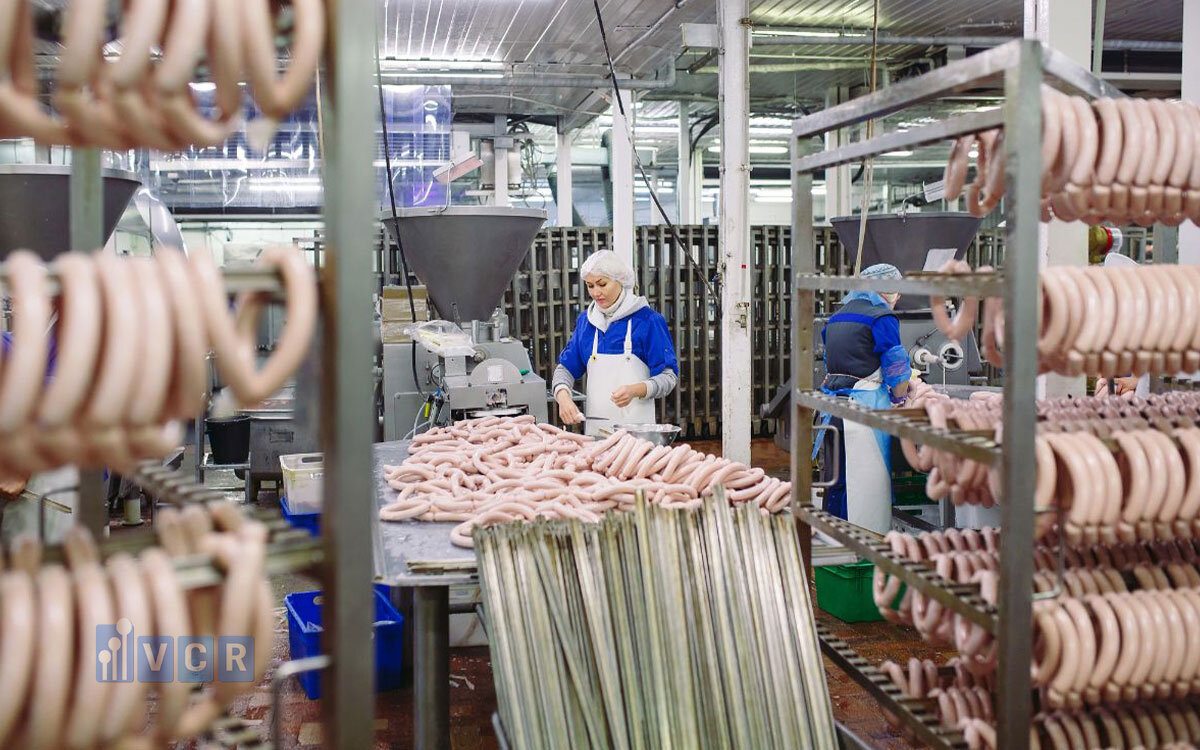
5. Best Practices for Installing and Maintaining Differential Pressure Gauges
Proper installation, calibration, and maintenance of differential pressure gauges are essential to ensure accurate readings, system efficiency, and regulatory compliance in food factories. Below are best practices to optimize gauge performance and longevity.
5.1. Proper Installation Guidelines
Choosing the Right Location for Accurate Readings
- Install the gauge in a location that reflects true pressure differences between clean and non-clean areas.
- Ensure it is placed at a consistent height and distance from air vents, doors, and pressure barriers.
- Avoid installing gauges near areas with strong vibrations, high humidity, or extreme temperatures, as these factors can affect performance.
Avoiding Common Installation Mistakes
- Incorrect positioning can cause inaccurate pressure readings. Make sure both input ports are aligned properly.
- Loose connections can lead to leaks and fluctuating readings. Ensure all tubing and fittings are secured tightly.
- Placing the gauge too close to high airflow zones (e.g., directly in front of HVAC vents) can distort pressure readings.
How to Test the Gauge After Installation
- After mounting, check for leaks using a pressure test kit.
- Use a reference gauge to verify accuracy before finalizing installation.
- If using a digital gauge or sensor, perform an initial system check to ensure proper integration with factory monitoring systems.
5.2. Regular Calibration & Maintenance
How Often Should Pressure Gauges Be Calibrated?
- Mechanical gauges: Calibration is recommended every 6 to 12 months.
- Digital gauges: Should be checked annually for accuracy.
- Pressure sensors (transmitters): Require periodic validation but often feature self-calibration functions.
Signs That a Gauge Needs Replacement or Recalibration
- Inconsistent pressure readings that do not align with expected system values.
- Fluctuating or drifting measurements even when factory conditions remain stable.
- Physical damage to the gauge, including cracked casing, loose fittings, or worn-out sensor components.
Preventative Maintenance Tips
- Regularly inspect and clean the gauge to prevent dust and debris buildup.
- Ensure the pressure tubing remains free of blockages or condensation, as this can impact readings.
- For digital gauges and sensors, check software updates to maintain optimal system compatibility.
5.3. Troubleshooting Common Issues
Gauge Not Displaying Accurate Readings
Possible Causes:
- Calibration drift due to long-term use.
- Blockages in pressure tubing.
- Sensor malfunction or electrical interference in digital models.
Solutions:
- Perform a manual calibration check.
- Clean or replace pressure tubing.
- If using a digital model, reset or update software settings.
Sudden Pressure Fluctuations
Possible Causes:
- HVAC system malfunction causing pressure instability.
- Air filters clogged or improperly maintained.
- Factory doors frequently opening, affecting airflow balance.
Solutions:
- Inspect HVAC system performance and adjust settings if needed.
- Replace or clean air filters regularly.
- Implement airlock procedures to reduce pressure disruptions.
How to Replace a Faulty Gauge Without Disrupting Operations
- Schedule replacements during non-peak production hours to minimize downtime.
- Use a backup gauge or manual pressure monitoring during the swap.
- For digital gauges and sensors, ensure new devices are configured properly before full activation.
Following these best practices ensures reliable performance, regulatory compliance, and a stable production environment in food factories. The next section will conclude with final recommendations on choosing the best differential pressure monitoring solutions for long-term success.
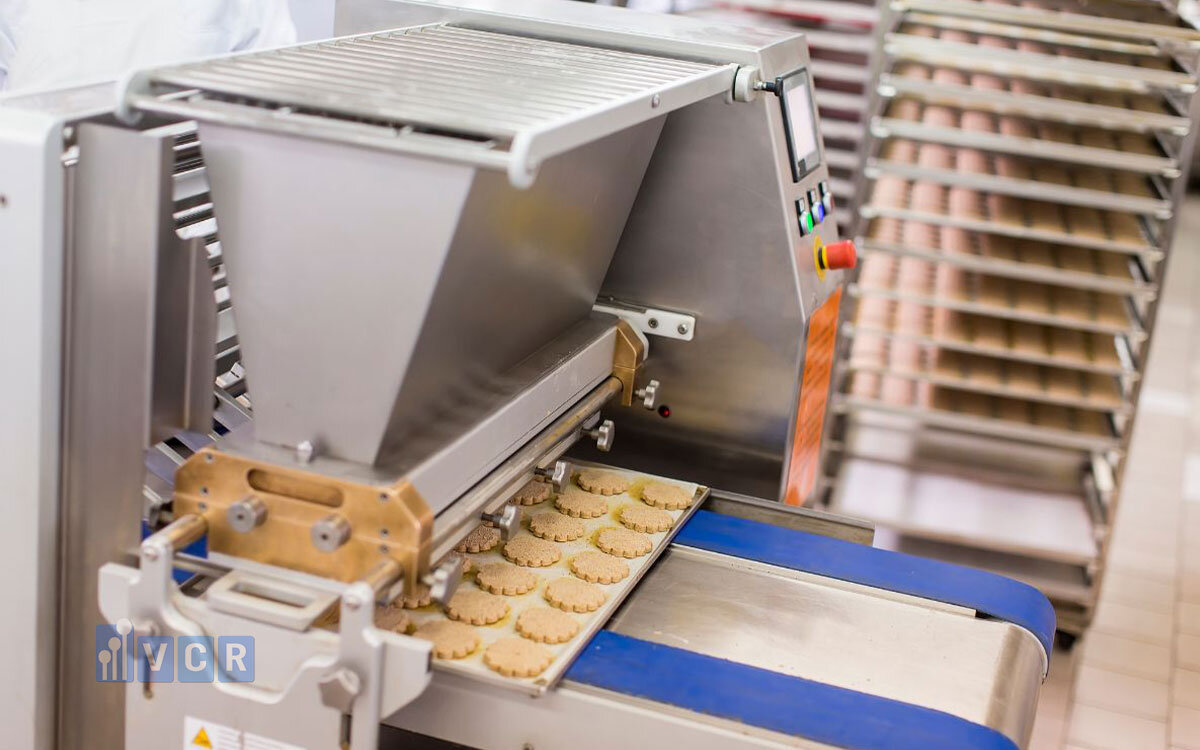
6. Conclusion
Choosing the right differential pressure gauge is a crucial decision for food manufacturers looking to maintain food safety, regulatory compliance, and operational efficiency. A well-monitored differential pressure system ensures proper airflow, contamination control, and compliance with HACCP, GMP, and ISO 22000 standards. Whether for cleanrooms, storage areas, or automated production lines, selecting the most suitable gauge can significantly enhance the reliability and stability of a food production environment.
Summary of Key Takeaways
Differential pressure monitoring is essential for preventing contamination, maintaining clean environments, and ensuring proper ventilation in food factories.
Mechanical differential pressure gauges are cost-effective and ideal for basic monitoring in food storage and packaging areas.
Digital differential pressure gauges offer higher accuracy, real-time monitoring, and alarm functions, making them suitable for cleanrooms and production areas requiring precise pressure control.
Differential pressure sensors provide advanced automation, seamless HVAC integration, and high precision, making them the best choice for automated food production lines and high-precision processing environments.
Proper installation, calibration, and maintenance are critical to ensuring long-term accuracy and efficiency. Regular checks help prevent gauge malfunctions, pressure fluctuations, and costly downtime.
Final Recommendations Based on Different Factory Needs
For warehouses, storage rooms, and secondary packaging areas → A mechanical differential pressure gauge is sufficient due to its durability and low maintenance.
For cleanrooms, food processing areas, and HACCP-certified zones → A digital differential pressure gauge is recommended for better accuracy, compliance monitoring, and remote tracking.
For automated food production lines, precision processing, and HVAC-integrated systems → A differential pressure sensor provides the highest level of accuracy and automation, ensuring full integration with modern monitoring systems.
Encouragement to Invest in High-Quality Gauges
Investing in high-quality differential pressure gauges not only ensures regulatory compliance and product safety but also reduces long-term operational costs by minimizing maintenance needs and improving energy efficiency. Selecting the right device prevents production issues, maintains consistent airflow, and safeguards the integrity of food products.
By following these guidelines, food manufacturers can maintain an optimal production environment, ensuring product quality, compliance, and efficiency. Making an informed choice today will lead to long-term success and reliability in food manufacturing operations.
PN






